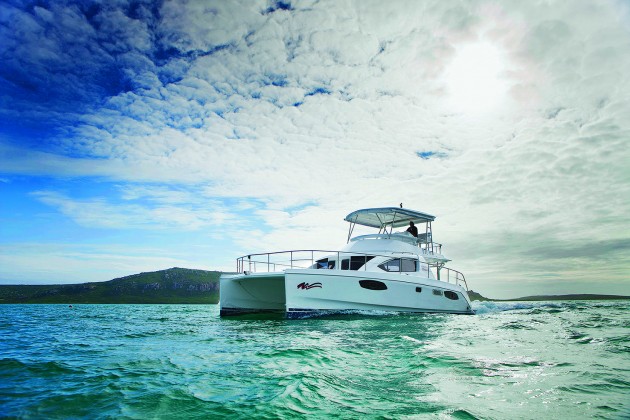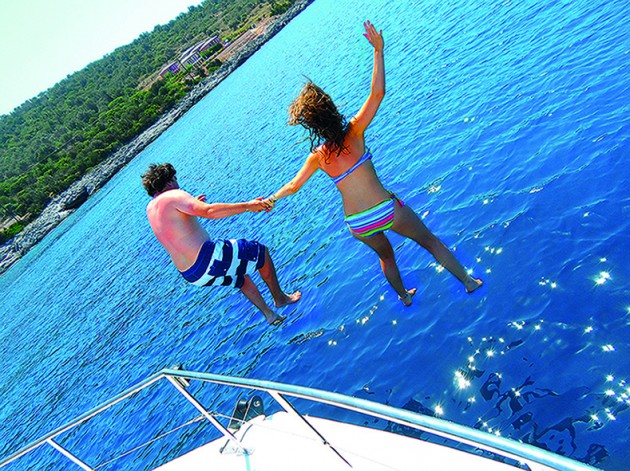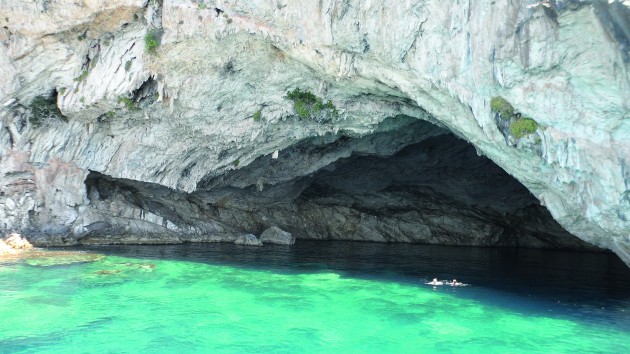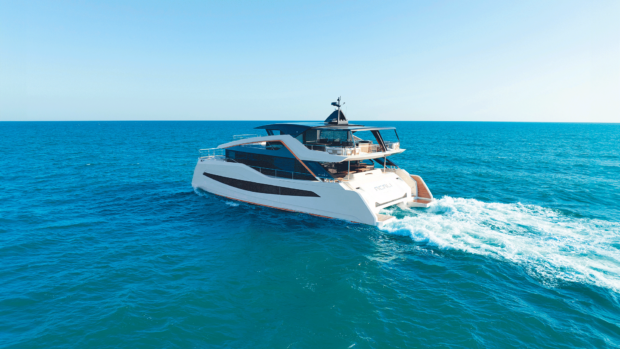A luxury motor cat, sunny island hopping, and good local wine - what more could you want from a charter holiday? A Guide to chartering a powercat.
The pros and cons of the powercat has
been a frequent topic of conversation in the Haines household. We’ve always loved the
idea of all that deck space, lots of sleeping accommodation, stability at anchor and good seakeeping. We even flirted with buying a Lagoon Power 43 on two occasions but the feasibility of keeping a big cat in a UK marina, where you’re likely to be charged up to 50% more for berths, has always prevented us from committing to life on two hulls.
In Greece, though, and specifically the south Ionian, this doesn’t matter because if you want to stay somewhere overnight it’s normally free and you just squeeze into a spot on the quayside or anchor off and tender to shore. No extortionate charges, just the expectation that if you use water and electricity you eat dinner in the restaurant whose owner provides such services, which is rarely a chore.
Choosing the charter
So this is the place to have a cat, or better still, to charter one. The Moorings supplied ours from its impressively well-run base at Levkas Marina, one of the few marinas in the area. As a place to meet your charter boat it doesn’t get much better; we were met at the airport by The Moorings’ minibus and 40 minutes later were standing on the pontoon next to our Leopard 39, branded by The Moorings as a 393PC. The air-con was blowing, the complimentary wine was perfectly chilled and the weather on arrival (flawless) set the tone for the rest of the week. The boat’s three-cabin layout worked perfectly for a group of our size (me, my girlfriend, my parents and my sister) with three double cabins and two toilets. My parents were treated to the entire starboard hull, which houses a large double bed at one end, enormous ensuite at the other and a large changing and office space in between. The port hull has a double cabin at each end and a bathroom in the middle.
Ideal for novices
The next morning we slid the boat out of her berth and nosed
into the Levkas canal, a narrow channel marked with withies,
which leads down to the most northern cluster of islands.
Our first night stop was in Spartochori, Porto Spilia on the island of Meganisi. The town teeters atop a craggy cliff face with a small beach at the bottom on which the single taverna is built. The taverna owner has two pontoons, which he runs with military precision barking orders at skippers, right down to which engine to have in which gear. Like it or not, he knows what he’s doing and is the perfect host for new skippers learning the ropes on unfamiliar charter boats.
Once berthed we watched other charter boats come in for the evening and saw nets of fresh fish being delivered still wriggling onto the quay in front of us. The taverna owner (now much smilier) gave us a guided tour of the kitchen. We chose our fish and then sat down on one of the tables wedged into the stoney beach with the waves lapping at our feet, the sun plunging
the sky into a reddish haze and a glass of local white wine in hand.
That idyllic start was momentarily shattered at 3am, though, when a strong north-easterly blew up and began battering our formerly sheltered pontoons. Even our super-stable cat was jumping around like its namesake on a hot tin roof, and we were up and on deck fending off the sailing boat on our port side.
Meganisi magic
The next morning we rose to clear skies and light winds and made the short trip around the corner to the port of Vathi. This small waterfront town is the perfect place to go for some berthing practice. You can’t guarantee lazy lines in Greek ports and instead berth by dropping the anchor as you reverse towards the quay, attaching
stern lines and then tightening the anchor and suspending the boat between it and the stern lines.
Vathi is small with a handful of restaurants on the quayside and lots of space to perfect your manoeuvres. But the real bonus is that from pretty much every part of this small U-shaped port you have stunning views out to the other islands and sparkling sea. We liked it so much that we decided to make it our night stop and pottered out to find a secluded cove for lunch close by. On the way out we had a quick nose at the crashed plane, which lies on the sea bed on Vathi’s eastern side marked by a small yellow buoy. It’s an intriguing spectacle, if a little eerie.
We nestled into one of the nooks on the east of the island for our lazy afternoon lunch. The motor cat almost spanned the entire cove and we dropped the hook and took a long line ashore. It was as perfect as anchorages get – white sand below, emerald-green warm water swishing around us and a small private beach at the head of the cove all to ourselves.
That evening we took a berth at the Odyseas Marina on Vathi’s western side. This was our only pay-for mooring of the trip but at ¤47 including water, electricity and lovely facilities even that was excellent value.
The next day we made for the port of Sivota on Levkas’s southern coast. On the way down we paid a visit to the sea caves near Meganisi’s tail. This is a must if you’re in the area – the caves are marked on the chart but their gaping entrances are easy to spot from the sea. The water is 100m deep until you’re within around 25ft of the gigantic openings where it shallows off to a perfectly safe 10m.
The leg to Sivota was our longest yet but this was no hardship. The sea is so calm and the weather so good that you make the journey part of the day, cruising along slowly soaking up the sun, reading and doing as you would at anchor. Again, the catamaran is perfect for this, it only cruises at 10 knots anyway and it’s so stable that moving around and sunbathing when the boat is moving couldn’t be easier.
Sivota is inconspicuous from the sea but once through its dogleg entrance with towering cliffs either side the channel opens up into a sheltered, horseshoe basin. The entire perimeter is quayside except for a few breaks for small stoney beaches, so you can just pick your spot and berth. We were enticed onto Stavros’s pontoon. The staff took our stern lines and handed us the lazy lines (thank goodness we did all that anchoring practice!) and we were set for the night.
Paradise holidays
Sivota was our favourite stay of the week. The shelter it provides means a handful of boats anchored right in the middle of the port. Watching them stream into the basin from the comfort of a quayside bar was utterly blissful and as darkness fell their anchor lights, like low-hanging stars, led a twinkling path from one side
of the port to the other. For supper we headed to Stavros’s restaurant, where the food, like most of the restaurants in this area, was unfussy, delicious and excellent value. Traditional dishes such as saganaki (fried cheese) and starters of Greek salad, tzatziki and nutty houmous were always a favourite.
The next day we headed west to Vasiliki, famed as one of Europe’s best windsurfing spots. We berthed on the huge stone quay tucked right in the corner of the bay. The view was breathtaking; our vista filled with the towering hillside to the west and gorgeous views south to the open sea. The town won’t be to everyone’s taste as it’s a little busier than some of the sleepier ports but we enjoyed the bustle and the peppering of waterfront bars and restaurants gave lots of options for sundowners, supper and nightcaps. Head to the restaurant just off the main moorings on the quay wall, which serves excellent seafood pasta and has a view out to sea to die for.
Kefalonia cruising
After an excellent breakfast in town we journeyed down to Kefalonia the next day. Once again it was flat calm without a hint of wind and with the engines purring along and autopilot doing its job we could just let the boat carve a perfect white crease into the blue. With the sun beating down and cold cans of local Mythos beer in hand life really couldn’t have been better.
Fiskardo is easy to find on Kefalonia’s northern tip but the vast superyacht anchored just outside made its entrance even easier to spot. The picturesque port has a cobbled quayside with pastel awnings and draws many visiting boats. So many, in fact, that there was no space on the quay and not much room to long line to the shore opposite. With no room at the inn we pushed on south between Ithaca and Kefalonia towards Eufimia. Before we reached Eufimia we stopped for a quick lunch and a swim but ran into trouble. It’s so deep around Kefalonia that you have to be mere feet away from the rocky coast before you have any chance of the anchor taking hold. The issue then is that you’re so close to land it takes one quick change of wind to put you on the rocks. We eventually gave up and just drifted while we ate.
Eufimia sits at the base of a rocky gully and the wind pours down towards the port from the western side of the island. We felt the full force of this as we headed directly into it to reach the quayside. Having handled the cat in and out of plenty of berths I was confident that its stability in the water would be enough to match the winds. It wasn’t the prettiest arrival (the anchor began to freefall
and the lines were a mess) but it added a bit of drama to another sun-drenched day. The port was not the most charming we’d visited but we found a cracking seafood restaurant perched on a raised ledge at the end of the quay and a lively bar to sit with a drink and watch the world go by.
Top of the charters
We awoke the next morning happy that we had a glorious 35nm trip back up to Levkas to complete but sad that this was the last trip of the charter. The journey north summed up neatly why we loved this holiday so much, the weather was once again glorious and the boat clipped along effortlessly allowing us to enjoy the elements and relax. We stopped off between Meganisi’s west coast and one of the outlying islands and dropped the anchor in white sand and 10ft of water for our final lunch of fresh meats, cheese and Greek salad all washed down with a bottle of the (rather good) local white wine. Minus a fork over board, which we failed to retrieve despite an hour-long diving competition, we couldn’t have wished for a more perfect end to an incredible week.
The final leg back to Levkas went without a hitch and with the evening sun still heating our backs we eased back into our home berth and enjoyed a dinner in one of the port’s lovely restaurants.
These cruising grounds are without doubt some of the finest that Europe has to offer and with no mooring fees, and glorious islands to explore at leisure, a motor cat was the perfect way to enjoy them.
The charter
Our Moorings 393PC was supplied by The Moorings (www.moorings.co.uk) from its marina base in Levkas. The cat’s twin 110hp Volvo diesels gave a cruising speed of 10 knots and around 12 knots flat out. The cost for a week’s charter in the first week of July was £4,395 plus a very reasonable £400 on fuel.
We flew to Preveza airport, which is well served by UK airlines. The service provided by The Moorings was top notch with excellent communication before and during our trip. The service was much more thorough than some other charter companies we’ve used before and this peace of mind meant we could enjoy our holiday all the more. The company sends out a detailed information pack before you fly which includes full information on the cruising area as well as safety advice and suggested itineraries for your charter.
You must have at least an ICC to bareboat charter in Greece. Checks of the boat papers are few and far between – we only had them checked on the night that we stayed in a marina and there is no real presence of officials in the area.
Cruising notes
Imray G12 South Ionian Islands charts cover Levkas to Zakinthos. Ionian by Rod Heikell was the pilot book that we used but charts and other pilot books are provided with the boat.
Cruising around these islands is very safe. There is one nasty rock just north of Meganisi but it’s marked on the chart and that aside there is nothing to hit and the water is incredibly deep.
The depth of the water can make anchoring around Kefalonia tough because you have to be so close to shore for the anchor to take but long lining makes life easier. Strong winds are much less of an issue here than in Croatia, for instance, and winds are generally very light.
Originally published in Motor Boat & Yachting, issue February 2013.












